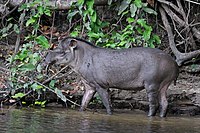
Photo from wikipedia
The subgenus Phyllodia (genus Pteronotus) comprises 9 species ranging from the western coast of Mexico to central Brazil, including Greater and Lesser Antilles. Two of them, Pteronotus rubiginosus and Pteronotus… Click to show full abstract
The subgenus Phyllodia (genus Pteronotus) comprises 9 species ranging from the western coast of Mexico to central Brazil, including Greater and Lesser Antilles. Two of them, Pteronotus rubiginosus and Pteronotus sp. 1, form an endemic South American clade within Phyllodia and are reported in sympatry for several localities in Guyana, Suriname, French Guiana, and northern Brazil. We herein performed a comprehensive investigation to fully characterize the cranial variation and genetic intraspecific structuring within this clade. We also integrated genetic, morphological, and acoustic evidence to formally describe the species previously reported as Pteronotus sp. 1. Specimens of P. rubiginosus occurring in sympatry with the new species have a more distinctive cranial phenotype than those from allopatric areas, suggesting character displacement as a potential force promoting divergence by decreasing resource competition or reproductive interactions between them. Although the 2 species are sympatric in several localities, the divergence in their echolocation calls also may be promoting resource partitioning at the microhabitat level, with P. rubiginosus foraging in less cluttered areas and the new species restricted to more cluttered areas.
Journal Title: Journal of Mammalogy
Year Published: 2018
Link to full text (if available)
Share on Social Media: Sign Up to like & get
recommendations!